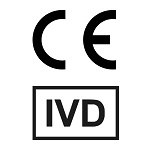Mouse anti Cytokeratin 19 / Keratin K19
Cat# MUB0329P-CE/IVD
Size : 0.1mg
Brand : Nordic Mubio
| Clone | RCK108 |
| Isotype | IgG1 |
| Product Type | Primary Antibodies |
| Units | 0.1 mg |
| Host | Mouse |
| Species Reactivity | Human Zebrafish |
| Application | Flow Cytometry Immunocytochemistry Immunohistochemistry (frozen) Immunohistochemistry (paraffin) Western Blotting |
Background
Cytokeratins are a subfamily of intermediate filament proteins and are characterized by a remarkable biochemical diversity, represented in Human epithelial tissues by at least 20 different polypeptides. They range in molecular weight between 40 kDa and 68 kDa and isoelectric pH between 4.9 – 7.8. The individual Human Cytokeratins are numbered 1 to 20. The various epithelia in the Human body usually express Cytokeratins which are not only characteristic of the type of epithelium, but also related to the degree of matuRation or differentiation within an epithelium. Cytokeratin subtype expression patterns are used to an increasing extent in the distinction of different types of epithelial malignancies. The Cytokeratin antibodies are not only of assistance in the differential diagnosis of tumors using immunohistochemistry on tissue sections, but are also a useful tool in cytopathology and flow cytometric assays.
Source
RCK108 is a mouse monoclonal IgG1 antibody derived by fusion of SP2/0-Ag14 mouse myeloma cells with spleen cells from a BALB/c mouse immunized with a cytoskeletal preparation of human bladder carcinoma cell line T24.
Product
Each vial contains 100 ul 1 mg/ml purified monoclonal antibody in PBS containing 0.09% sodium azide.
Formulation: Each vial contains 100 ul 1 mg/ml purified monoclonal antibody in PBS containing 0.09% sodium azide.
Specificity
RCK108 reacts exclusively with Cytokeratin 19 which is present in glandular-type epithelia and most carcinomas. Does not react with hepatocytes and hepatocellular carcinoma.
Applications
RCK108 is particularly well suited for use in immunohistochemistry on paraffin-embedded tissues after pretreatment with microwave oven based antigen retrieval with destilled water. RCK108 is also useful for immunocytochemistry, immunohistochemistry on frozen sections, immunoblotting and flow cytometry. Optimal antibody dilution should be determined by titration; recommended range is 1:100 – 1:200 for flow cytometry, and for immunohistochemistry with avidin-biotinylated Horseradish peroxidase complex (ABC) as detection reagent, and 1:100 – 1:1000 for immunoblotting applications.
Storage
The antibody is shipped at ambient temperature and may be stored at +4°C. For prolonged storage prepare appropriate aliquots and store at or below -20°C. Prior to use, an aliquot is thawed slowly in the dark at ambient temperature, spun down again and used to prepare working dilutions by adding sterile phosphate buffered saline (PBS, pH 7.2). Repeated thawing and freezing should be avoided. Working dilutions should be stored at +4°C, not refrozen, and preferably used the same day. If a slight precipitation occurs upon storage, this should be removed by centrifugation. It will not affect the performance or the concentration of the product.
Caution
When used for in vitro diagnostic purposes results must be put within the context of other diagnostic tests as well as the clinical history of the patient by a certified professional before final interpretation. Analyses performed with this antibody should be paralleled by positive and negative controls. If unexpected results are obtained which cannot be attributed to differences in laboratory procedures, please contact us. This product may contain hazardous ingredients. Please refer to the Safety Data Sheets (SDS) for additional information and proper handling procedures. Dispose product remainders according to local regulations.This datasheet is as accurate as reasonably achievable, but Nordic-MUbio accepts no liability for any inaccuracies or omissions in this information.
References
1. Kwaspen, F. H., Smedts, F. M., Broos, A., Bulten, H., Debie, W. M., and Ramaekers, F. C. (1997). Reproducible and highly sensitive detection of the broad spectrum epithelial marker keratin 19 in routine cancer diagnosis, Histopathology 31, 503-16.
CE Mark
CE
Protein Reference(s)
Database Name: UniProt
Accession Number: P08727
Safety Datasheet(s) for this product:
 NM_Sodium Azide NM_Sodium Azide |

Figure 1. MUB0329P immunohistochemistry on frozen section of human liver bile duct epithelium.

Figure 2. MUB0329P immunofluorescence staining of a 9 days old zebrafish embryo.

Figure 3. Immunohistochemistry on a frozen tissue sections of human kidney with MUB0329P (RCK108; dilution 1:500).

Figure 4. Immunohistochemistry on frozen tissue sections of human colon with MUB0329P (RCK108; dilution 1:500).

Figure 5. Indirect immunoperoxidase staining of human small intestine paraffin tissue section with MUB0329P (RCK108; Mouse anti keratin 19). Dilution 1:50 and microwave pretreatment. Specific staining of the epithelial cells. No reactivity in the connective tissues.

Figure 6. Indirect immunoperoxidase staining of human placenta paraffin tissue section with MUB0329P (RCK108; Mouse anti keratin 19). Dilution 1:50 and microwave pretreatment. Specific staining of the epithelial cells. No reactivity in the connective tissues.

Figure 7. Indirect immunoperoxidase staining of human colon adenocarcinoma paraffin tissue section with MUB0329P (RCK108; Mouse anti keratin 19). Dilution 1:50 and microwave pretreatment. Specific staining of the epithelial tumor cells. No reactivity in connective tissues.




